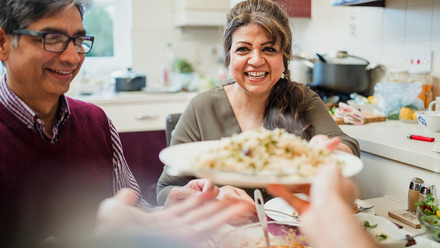Introduction
Background
Hack Criteria
To create an impactful resource which dietitians can share with the public so that they can act on the information, careful consideration was given to the criteria.
We asked dietitians to:
-
Provide clear details about the swap with regard to what has changed from the original meal to the sustainable hack
- Consider all eating and drinking occasions across the day - including breakfast, lunch, dinner, snacks, drinks
- Consider practicality and relevance to ‘average’ UK consumer
- The smaller the deviation, the greater the reality of consumers adopting. Aim for minimal degree of deviation between the original meal and swap.
- Sustainable swap/hack to be significantly increased in healthy plant-based ingredients.
- Add on further deviations that could be made
- Consider price implications – the switch should not cost more than the original
- Outline the environmental and nutritional impact of the hack
A social media and digital marketing campaign was launched to engage members with the competition and we received 30 entries over six weeks. The submissions were of a very high standard and clearly showed that generally the dietitians and student dietitians has taken on board the key recommendations from the One Blue Dot Reference guide.
Our judging panel (with dietitians representing the BDA Sustainable Diets Specialist Group and dietitians representing project supporter Alpro) assembled to review to entries. They selected the top 5 against the criteria set out.
The winning hacks were the ones which most clearly articulated the simple swaps required to improve the nutritional value of the meal and its contribution towards a more sustainable eating pattern.
Porridge
Recipe
| Serves: 1 | |
|
ORIGINAL |
HACK 1 – Berry bowl |
|
Ingredients 40g porridge oats 200mls semi-skimmed dairy milk 2 tsp sugar
|
Ingredients 40g porridge oats 200mls (calcium-fortified, unsweetened) soya drink Toppings 80g mixed berries (bought frozen and defrosted) 1 tbsp vanilla soya alternative to yogurt 1 dessert spoon flaked almonds |
Nutritional analysis
|
|
Original Porridge |
Berry Bowl Hack |
||||
|
|
100g |
Per serving 211g |
%RI |
100g |
Per serving |
%RI |
|
kJ |
555 |
1,1701 |
14% |
432 |
1313 |
16% |
|
Kcal |
131 |
276 |
14% |
102 |
311 |
16% |
|
Fat g |
3.1 |
6.6 |
9% |
3.4 |
10.4 |
15% |
|
Saturated fats g |
1.3 |
2.7 |
14% |
0.5 |
1.5 |
8% |
|
Carbs g |
21.9 |
46.1 |
18% |
12.9 |
39.1 |
15% |
|
Sugars g |
8.5 |
17.9 |
20% |
3.4 |
10.4 |
12% |
|
Fibre g |
1.5 |
3.1 |
10% |
2.3 |
7.1 |
24% |
|
Protein g |
5.4 |
11.4 |
23% |
4.4 |
13.5 |
27% |
|
Salt g |
0.10 |
0.22 |
4% |
0.07 |
0.20 |
3% |
Portion of 5 a day
|
Original Porridge |
Berry Bowl Hack |
||||
| 0 | 1 |
Download the full nutritional analysis with vitamin and mineral values
Carbon footprint analysis
Method and references available in tab above
|
Carbon footprint (kg CO2 equiv. per single serve) reduction |
kg CO2 equiv. values per serving |
Ingredient with biggest contribution to reduction in carbon footprint |
|
Down 14% |
Classic: 0.303 Berry bowl hack: 0.260 |
Shift from dairy milk to soya drink |
Nutritional analysis - References
-
Forestfield Software Ltd. Diet Plan version 7.00.56: McCance & Widdowson's 7th summary editions of The Composition of Foods plus the revised Composition of Foods integrated data set (CoFids) forming the complete UK Nutrient Databank. Patent Diet Plan7. 2019.
-
Plant-based drinks and alternative to yogurts: http://www.alpro.com
The nutritional analysis was completed using products from Alpro:
Burger
Recipe
|
Serves: 4 Prep time: 10mins Cook time: 15 mins |
|
|
ORIGINAL |
HACK* |
|
Ingredients 500g 10% fat steak mince 40g white breadcrumbs 1 small onion (chopped) 3 Sprigs of Fresh Parsley or 1 tbsp Dried Parsley 1 tbsp dried mixed herbs 1 medium whole egg 1 tbsp Dijon mustard Good pinch salt and pepper 4 White seeded burger buns Toppings per person Lettuce leaves 2-3 slices tomatoes A slice of onion Cucumber 2-3 pieces Grated carrot Sliced Gherkins Accompaniments per person Coleslaw (standard) ~2 large spoonfuls 165g fried chips
|
Ingredients 200g lean steak mince (3-5% fat) 175g green lentils rinsed and drained 40g brown breadcrumbs (approx. 2 slices) 1 small onion (chopped) 3 Sprigs of Fresh Parsley or 1 tbsp Dried Parsley 1 tbsp dried mixed herbs 1 medium whole egg 1 tbsp Wholegrain mustard 4 Wholegrain Buns Add additional seasoning to suit personal preferences Toppings per person Lettuce leaves 2-3 slices tomatoes A slice of onion Cucumber 2-3 pieces Grated carrot Sliced Gherkins Accompaniments per person 80g side salad 165g potato wedges - oven baked with oil |
|
Standard burger method – combine all ingredients and shape into burgers. Shallow fry the burgers. |
|
Nutritional analysis
|
|
Original Burger |
50/50 Lentil Meat Hack |
||||
|
|
100g |
Per serving 563g |
%RI |
100g |
Per serving 588g |
%RI |
|
kJ |
714 |
4,016 |
48% |
454 |
2,669 |
32% |
|
Kcal |
170 |
955 |
48% |
107 |
630 |
32% |
|
Fat g |
7.1 |
39.8 |
57% |
2 |
13.9 |
20% |
|
Saturated fats g |
1.6 |
8.8 |
44% |
0.5 |
3.1 |
16% |
|
Carbs g |
19.4 |
109.1 |
42% |
16.8 |
98.8 |
38% |
|
Sugars g |
2.6 |
14.6 |
16% |
2.2 |
13.1 |
15% |
|
Fibre g |
2.2 |
12.2 |
41% |
2.8 |
16.4 |
55% |
|
Protein g |
7.8 |
43.7 |
87% |
5.4 |
32 |
64% |
|
Salt g |
0.38 |
2.16 |
36% |
0.3 |
1.59 |
27% |
Portion of 5 a day
|
Original |
Hack |
|
2 |
2 |
Download the full nutritional analysis with vitamin and mineral values
Carbon footprint analysis
Method and references available in tab above
|
Carbon footprint (kg CO2 equiv. per single serve) reduction |
kg CO2 equiv. values per serving |
Ingredient with biggest contribution to reduction in carbon footprint |
| Down 51% |
Classic: 5.31 Hack: 2.58 |
97% of the reduction attributable to reducing red meat by more than half and replacing with plant proteins - lentils. |
Nutritional analysis - References
-
Forestfield Software Ltd. Diet Plan version 7.00.56: McCance & Widdowson's 7th summary editions of The Composition of Foods plus the revised Composition of Foods integrated data set (CoFids) forming the complete UK Nutrient Databank. Patent Diet Plan7. 2019.
* Based on a recipe from Good Housekeeping
Tikka Masala
Recipe
|
Serves: 4 |
|
|
ORIGINAL |
HACK |
|
Ingredients 8 chicken thighs, with skin 3 tbsp ghee 3 onions, chopped 200ml double cream 4 garlic cloves, crushed 1 tbsp minced ginger 2 tsp ground cumin 2 tsp garam masala 2 tsp paprika 2 x 400g can chopped tomatoes
Served with 240g (dried) Basmati white rice Lassi 2 x fresh Mangoes 800g natural low-fat dairy yogurt
|
Ingredients 4 chicken thigh fillets, skin removed 1 x 400g canned chickpeas, drained 1 tbsp vegetable (rapeseed) oil 3 onions, chopped 200g Unsweetened soya alternative to yogurt 4 garlic cloves 1 tbsp minced ginger 2 tsp ground cumin 2 tsp garam masala 2 tsp paprika 2 x 400g can chopped tomatoes Served with Wholemeal flatbread (instead of rice) 120g wholemeal flour ½ tsp baking powder Small pinch salt 120g unsweetened soya alternative to yogurt Seasonal side salad (80g per person) Lassi 320g season local sourced fruit/berries or frozen varieties. 800g plain soya with almond alternative to yogurt |
|
Curry
Lassi Blend with a handheld or upright blender. |
Curry
Flatbreads
Lassi: Blend with a handheld or upright blender. |
Nutritional analysis
|
|
Original Tikka |
50/50 Tikka Hack |
||||
|
|
100g |
Per serving 818g |
%RI |
100g |
Per serving 807g |
%RI |
|
kJ |
569 |
4,654 |
55% |
347 |
2,798 |
33% |
|
Kcal |
136 |
1,112 |
56% |
82 |
665 |
33% |
|
Fat g |
7.8 |
63.9 |
91% |
3 |
24.8 |
35% |
|
Saturated fats g |
3.8 |
31.4 |
157% |
0.5 |
4.4 |
22% |
|
Carbs g |
11.4 |
92.9 |
36% |
7.5 |
60.2 |
23% |
|
Sugars g |
5 |
41.2 |
46% |
3.3 |
26.5 |
29% |
|
Fibre g |
1.1 |
9.1 |
30% |
2.3 |
18.4 |
61% |
|
Protein g |
6 |
49 |
98% |
6.5 |
52.5 |
105% |
|
Salt g |
0.09 |
0.73 |
12% |
0.2 |
1.25 |
21% |
Portion of 5 a day
| Original |
Hack |
| 3 | 5 |
Download the full nutritional analysis with vitamin and mineral values
Carbon footprint analysis
Method and references available in tab above
|
Carbon footprint (kg CO2 equiv. per single serve) reduction |
kg CO2 equiv. values per serving |
Ingredient with biggest contribution to reduction in carbon footprint |
| Down 16% |
Classic: 2.50 Hack: 2.108 |
Chicken and poultry not as significant to the carbon footprint as red meat. Shifting from ghee to vegetable oil, using seasonal berries and plant-based alternative to yogurt were the main attributors to reducing the footprint. |
Nutritional analysis - References
-
Forestfield Software Ltd. Diet Plan version 7.00.56: McCance & Widdowson's 7th summary editions of The Composition of Foods plus the revised Composition of Foods integrated data set (CoFids) forming the complete UK Nutrient Databank. Patent Diet Plan7. 2019.
-
Plant-based drinks and alternative to yogurts: http://www.alpro.com
The nutritional analysis was completed using products from Alpro:
Shepherd's Pie
Recipe
|
Serves: 4 |
|
|
ORIGINAL |
HACK |
|
Ingredients 1 tbsp sunflower oil 1 large onion, chopped 2-3 medium carrots, chopped 500g pack 20% fat lamb mince 2 tbsp tomato purée large splash Worcestershire sauce 500ml beef stock 900g potato, cut into chunks Good pinch salt and pepper 85g salted butter 3 tbsp semi-skimmed dairy milk
|
Ingredients 1 tbsp sunflower oil 1 large onion, chopped 2-3 medium carrots, chopped 250g mycoprotein mince 2 tbsp tomato purée large splash Worcestershire sauce 300ml reduced salt vegetable or beef stock 1 400g can green lentils, drained 200g potato, cut into chunks 300g butternut squash, cut into chunks 30g PUFA spread 3 tbsp semi-skimmed dairy milk Served with 320g broccoli, boiled 320g carrots, boiled |
|
|
Nutritional analysis
|
|
Original Shepherd’s Pie |
Quorn/Vegan Hack |
||||
|
|
100g |
Per serving 528g |
%RI |
100g |
Per serving 536g |
%RI |
|
kJ |
566 |
2,989 |
36% |
277 |
1,483 |
18% |
|
Kcal |
135 |
716 |
36% |
66 |
352 |
18% |
|
Fat g |
8.6 |
45.6 |
65% |
2 |
10.5 |
15% |
|
Saturated fats g |
4.5 |
23.7 |
119% |
0.4 |
2.3 |
12% |
|
Carbs g |
10.1 |
53.6 |
21% |
8.1 |
43.2 |
17% |
|
Sugars g |
2 |
10.6 |
12% |
3.5 |
18.6 |
21% |
|
Fibre g |
1.4 |
7.4 |
25% |
3.2 |
17.1 |
57% |
|
Protein g |
5.2 |
27.2 |
54% |
3.7 |
20 |
40% |
|
Salt g |
0.35 |
1.86 |
31% |
0.1 |
0.68 |
11% |
Portion of 5 a day
|
Original |
Hack |
| 1 | 4 |
Download the full nutritional analysis with vitamin and mineral values
Carbon footprint analysis
Method and references available in tab above
|
Carbon footprint (kg CO2 equiv. per single serve) reduction |
kg CO2 equiv. values per serving |
Ingredient with biggest contribution to reduction in carbon footprint |
| Down 81% |
Classic: 5.31 Hack: 0.99 |
Majority of the drop in footprint due to replacing 100% lamb in the original recipe with a combination of mycoprotein and green lentils. |
Nutritional analysis - References
-
Forestfield Software Ltd. Diet Plan version 7.00.56: McCance & Widdowson's 7th summary editions of The Composition of Foods plus the revised Composition of Foods integrated data set (CoFids) forming the complete UK Nutrient Databank. Patent Diet Plan7. 2019.
- Mycoprotein values from: Quorn Website for Health Professionals - What is mycoprotein - Micronturients Profile https://www.quornnutrition.com/importance-of-micronutrients
Kofta
Recipe
|
Serves: 4 |
|
|
ORIGINAL |
HACK |
|
Ingredients 500g 20% lamb mince 1 onion, finely chopped ~30g panko breadcrumbs 2 cloves garlic, crushed 1 tbsp chopped fresh coriander 1 tbsp chopped fresh parsley 2 tsp ground cumin 1½ tbsp ras el hanout 1¼ tsp salt ½ tsp black pepper
Served with Tzatziki ½ a large cucumber, grated 350g 5% fat Greek-style yogurt 2 tbsp extra virgin olive oil 2 clove garlic, crushed 1 tbsp white vinegar 1 tbsp chopped fresh mint or 1 tsp dried mint ½ tsp salt
White pitta bread x 4 Mixed salad of chopped white cabbage, tomatoes, cucumber & onions. (~50g per person) |
Ingredients 2 x 400g canned green lentils, drained 1 onion, finely chopped 2 cloves garlic, crushed 1 medium egg (or 2 tbsp ground flaxseeds with water) 100g oats 1 tbsp chopped fresh coriander 1 tbsp chopped fresh parsley 1 tsp ground cumin 1 tbsp ras el hanout Zest of 1 lemon A tiny pinch of salt A good ground of pepper
Served with Tzatziki ½ a large cucumber, grated 350g Greek-style soya alternative to yogurt 2 tbsp extra virgin olive oil 2 clove garlic, crushed 1 tbsp white vinegar 1 tbsp chopped fresh mint or 1 tsp dried mint A small pinch of salt
Wholemeal pitta bread x 4 Mixed salad of chopped white cabbage, tomatoes, cucumber & onions. (~80g per person) |
Tzatziki:
Serve the kofta with toasted pitta bread, tzatziki, and salad. |
Tzatziki: as across. Serve the kofta with toasted pitta bread, tzatziki, and salad. |
Nutritional analysis
|
|
Original kofta |
Lentil Kofta Hack |
||||
|
|
100g |
Per serving 380g |
%RI |
100g |
Per serving 475g |
%RI |
|
kJ |
726 |
2,764 |
33% |
484 |
2,301 |
27% |
|
Kcal |
173 |
660 |
33% |
115 |
547 |
27% |
|
Fat g |
9.6 |
36.6 |
52% |
3 |
14 |
20% |
|
Saturated fats g |
4.3 |
16.4 |
82% |
0.5 |
2.4 |
12% |
|
Carbs g |
12.8 |
48.9 |
19% |
15.4 |
73.4 |
28% |
|
Sugars g |
2.8 |
10.8 |
12% |
2.3 |
11.1 |
12% |
|
Fibre g |
1.3 |
4.8 |
16% |
3.6 |
17.3 |
58% |
|
Protein g |
9.8 |
37.2 |
74% |
5.5 |
26.2 |
52% |
|
Salt g |
0.92 |
3.52 |
59% |
0.2 |
1.11 |
19% |
Portion of 5 a day
|
Original |
Hack |
| 1 | 2 |
Download the full nutritional analysis with vitamin and mineral values
Carbon footprint analysis
Method and references available in tab above
|
Carbon footprint (kg CO2 equiv. per single serve) reduction |
kg CO2 equiv. values per serving |
Ingredient with biggest contribution to reduction in carbon footprint |
| Down 87% |
Classic: 4.41 Hack: 0.56 |
Majority of drop attributed to the 100% switch from lamb to a lentils and oat mix. Minor improvements also gained from switching to a soya plant-based yogurt alternative dip. |
Nutritional analysis - References
-
Forestfield Software Ltd. Diet Plan version 7.00.56: McCance & Widdowson's 7th summary editions of The Composition of Foods plus the revised Composition of Foods integrated data set (CoFids) forming the complete UK Nutrient Databank. Patent Diet Plan7. 2019.
-
Plant-based drinks and alternative to yogurts: http://www.alpro.com
The nutritional analysis was completed using products from Alpro:
Environmental Analysis Methodology
The project was designed to encourage consideration of all areas of increasing sustainability in popular UK meals – including seasonality, packaging, shifts from animal to plant protein, portion size and food waste.
The UK government have specific targets around the reduction of greenhouse gas emissions equivalent (GHGe) and one way to engage the pubic with this, and to encourage them to play an active role is to model the ‘carbon footprint’ of popular meals. As part of this project we have investigated only one environmental factor of our food choices - the estimated GHGe output of each recipe. However, we must not forget the more complex and larger impact our food choices have on our planet e.g. land use, water use and pollution, soil pollution, loss of biodiversity, acidification of our oceans.
Carbon footprint – Methodology for calculations
Each recipe was analysed for kg CO2 eq using 5 different accredited databases for kg CO2 eq of different foods.
- All databases provided carbon footprint data as kg CO2 eq per kg food weight
Each recipes' ingredients and weight was inputted into an excel spreadsheet:
- Best matches for each ingredient was retrieved from the accredited databases
- Wherever possible, the UK specific accredited databases were used**
- Where data was not available from UK databases, data was sourced from European and global databases.
- Database CO2 eq per kg values were adjusted for the recipe specified ingredient weight
Some ingredients could not be identified or a close match found:
- Porridge hack: mixed frozen berries – replaced with fresh field grown local berries
- Shepherd’s pie: Worcester sauce – omitted from calculations (used in pre and post hack recipes in the same quantities)
- Kofta tzatziki: vinegar – omitted from calculations (used in pre and post hack recipes in the same quantities)
- Burger classic recipe: coleslaw accompaniment – mayonnaise – omitted
- Generic across most recipes
- Dried herbs – value for spices used
- Fresh herbs – values for field grown lettuce leaves used as per the herb ingredient (used in pre and post hack recipes in the same quantities)
- Wholegrain mustard – values for mustard seeds only available
- Stock in recipes: stock cube weight used against generic ‘spices’ database value and ‘tap water’ for volume specified in recipe. (across both original and hacked recipes)
- Tinned tomatoes – generic ‘tinned vegetable’ value used as closest match – Green et al 2015 – UK specific
- Tomato puree – database values for ‘tomatoes’ multiplied by 5 (to accommodate concentration of tomatoes)
- Wholemeal bread/pitta/burger rolls – only generic ‘bread’ values available
- Soya alternative to yogurt – Soya drink values were used in place of this
Datasets used for analysis
-
**Clune S, Crossin E & Verghese K. Systematic review of greenhouse gas emissions for different fresh food categories. J Cleaner Production 2017;140(Part 2):766-783
-
**Scarborough P, Appleby PN, Mizdrak A, Briggs ADM , Travis RC, Bradbury KE, Key TJ. Dietary greenhouse gas emissions of meat-eaters, fish-eaters, vegetarians and vegans in the UK. Clim Change 2014;125(2):179-192 doi: 10.1007/s10584-014-1169-1. Epub 2014 Jun 11
- **Green R, Milner J, Dangour AD, Haines A, Chalabi Z, Markandya A, Spadaro J & Wilkinson P. The potential to reduce greenhouse gas emissions in the UK through healthy and realistic dietary change. Clim Change 2015;129:253–265
- Poore J, Nemecek T. Reducing food's environmental impacts through producers and consumers. Science 2018;360(6392):987-992
- Audsley E, Brander M, Chatterton J, Murphy-Bokern D, Webster C & Williams A. (2009). How low can we go? An assessment of greenhouse gas emissions from the UK food system and the scope to reduce them by 2050. FCRN-WWF-UK.
- **https://www.quorn.co.uk/carbon-footprint







